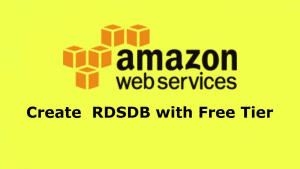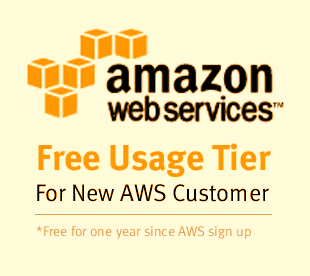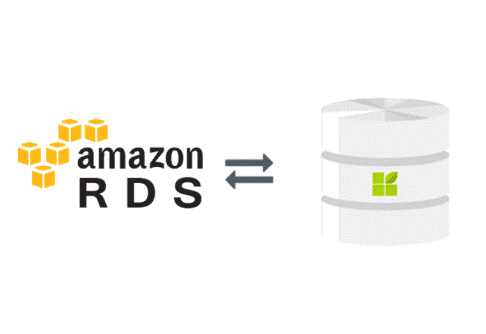AWS RDS Free Tier
AWS Free Tier includes the following:

AWS RDS Free Tier – AWS Free Tier Symbol
– 20 GB Storage
– 750 hrs Amazon RDS (db.t2.micro Instance)
– 20 GB for Backups every single month for the period of 1 year.
You need to enter a valid credit card for the sake of signing up. In case you previously possess an account, you can directly head to the Management Console to get started through the following link https://console.aws.amazon.com/rds/home.
AWS RDS Free Tier Includes:

AWS RDS Free Tier – Create AWS RDS with Free Tier
- 20 GB backup storage for automated database backups and whichever DB Snapshots are user-initiated
- 750 hours RDS Single-AZ db.t2.micro Instance usage
- 20 GB General Purpose DB Storage
- Oracle BYOL db.t3.micro Single-AZ Instance usage as part of RDS free tier
Also, you have the Management Console for free to help you with building and managing your DB Instances on RDS.
Where can the AWS Free Tier be used?

AWS RDS Free Tier – AWS Free Usage Tier for New AWS Customer
– It’s going to be available for twelve months from the beginning of the date of creating your AWS account. Upon the expiry of the free usage and when the usage of your app goes over the limit of the free usage tiers, you will have to pay the cost of the standard pay-as-you-go service rates inflicted, and there will be restrictions that are going to be applied.
– It is applied over every single Region, excluding that of the Asia Pacific (Osaka) Local and GovCloud (US) Regions. This usage gets calculated every month in every one of the regions and it will be directly applied as a charge on the bill. This means that, for example, you receive 750 Micro DB Instance hours free of charge for all the Regions and not 750 hours for each one of the Regions.
Keep in mind that free usage will not be accumulating from one specific billing period to another.
– Amazon RDS free tier will be applied to the RDS for the following:
- MySQL
- PostgreSQL
- MariaDB
- Oracle (Bring-Your-Own-License)
- SQL Server (SQL Server Express Edition)
Why would you refer to using Amazon RDS today?

AWS RDS Free Tier – AWS RDS DB Benefits
Well, the answer is easy and simple because of the following reasons mentioned below:
– It’s a very hard job to deploy and manage databases, it also takes a lot of your time, and it’s one of the activities in IT which cost a fortune.
– RDS defeats the complexity by automating a lot of the unnoticed tasks that require a lot of time and are important, as well as administrative, like installing software and patching, provisioning hardware, performing backups for disaster recovery and managing storage.
– RDS allows database administrators and developers to get some extra free time to concentrate on creating innovative ideas.
– With RDS, you will be able to swiftly scale your computing capacity when your app requires more room to grow.
– With RDS, you will be able to handle database management tasks that require a lot of time in order for you to go for some greater and better value app development.
In case you are someone who manages their very own database deployments, you now have the chance to change to Amazon RDS to obtain the below-listed benefits and advantages:
| Characteristics | Amazon RDS | Self-Managed Database |
|---|---|---|
| Deployment with Point-and-click in just a couple of minutes using already configured parameters | Yes | No |
| Scaling compute resources easily with a couple of clicks or through a single API call | Yes | No |
| Disaster recovery and backups automatically | Yes | No |
| Managed database snapshots for database cloning or backup | Yes | No |
| Accessing hardware + Total environment control | No | Yes |
| Software Patching Automatically | Yes | No |
| Compatible with already existing tools and apps | Yes | Yes |
| Providing metrics on disk, memory and CPU utilization in a dashboard for free | Yes | No |
Additional Key Features Include the following Characteristics:
– Scalable –
With a couple of clicks on your Management Console, you will easily be able to start scaling up your instance type all the way going from its smallest to whatever is in between until reaching the largest. Keep in mind the following: When you use the scale compute feature, you are going to be consuming capacity way over that of the available free tier usage capacity, which means that you shall get charged for standard, pay-as-you-go rates for the extra capacity that you’re using.
– Manageable –
RDS directly patches your OS software and allows you to get your database software updated automatically. It also enables you to get complete visibility into disk, memory and CPU utilization using the Management Console.
– Data Durable and Disaster Recovery –
The automated backup is an RDS feature that is set as on by default, and it enables point-in-time recovery for your DB Instance. Amazon RDS is capable of backing up your transaction database and transaction logs and storing them for a retention period of time which is user-specified. By doing this, you will be able to restore your DB Instance to whichever second you choose from the retention period until the final 5 minutes. You are granted an automatic backup retention period which is capable of being configured for a maximum of up to thirty-five days.
See Also